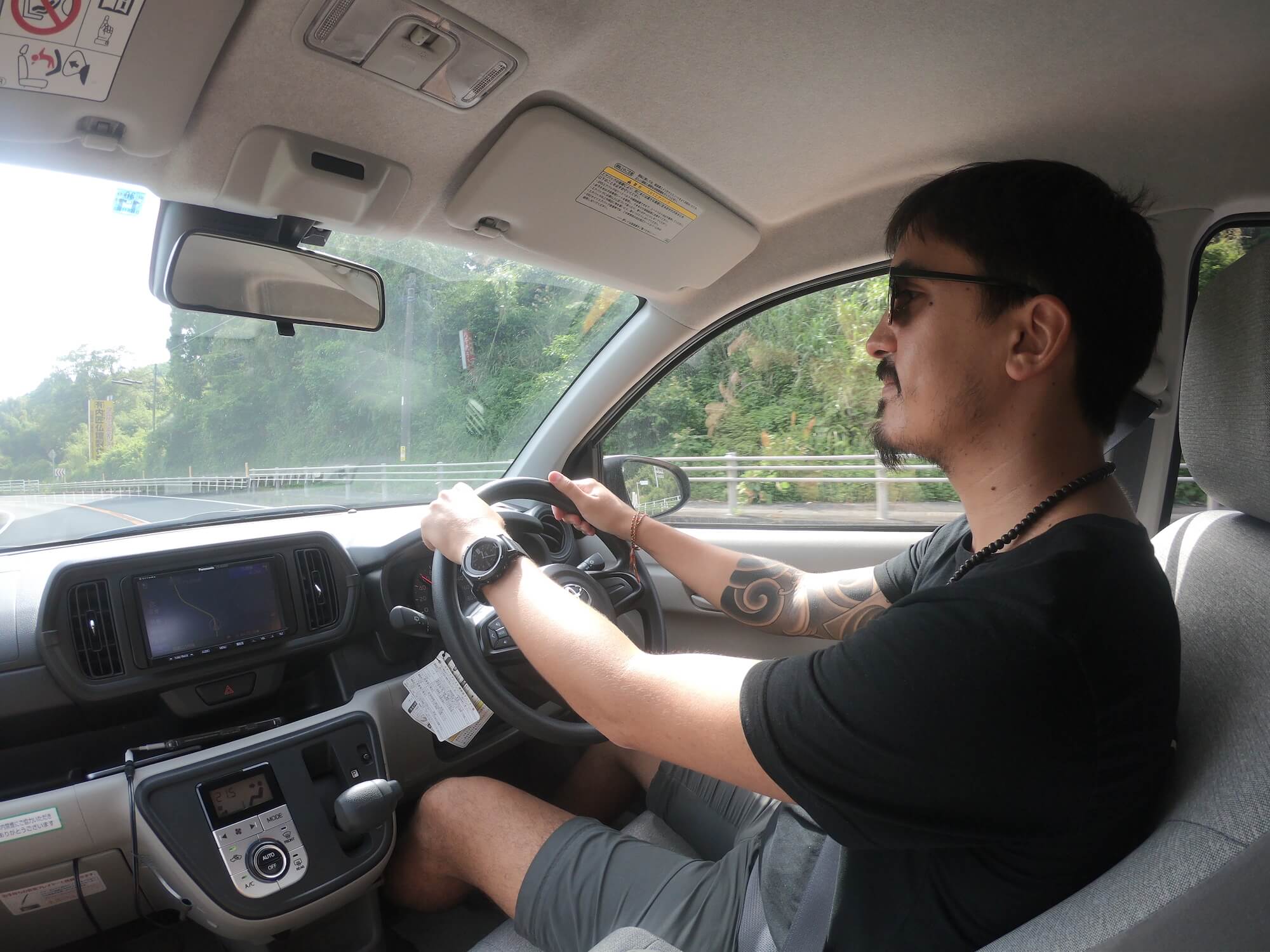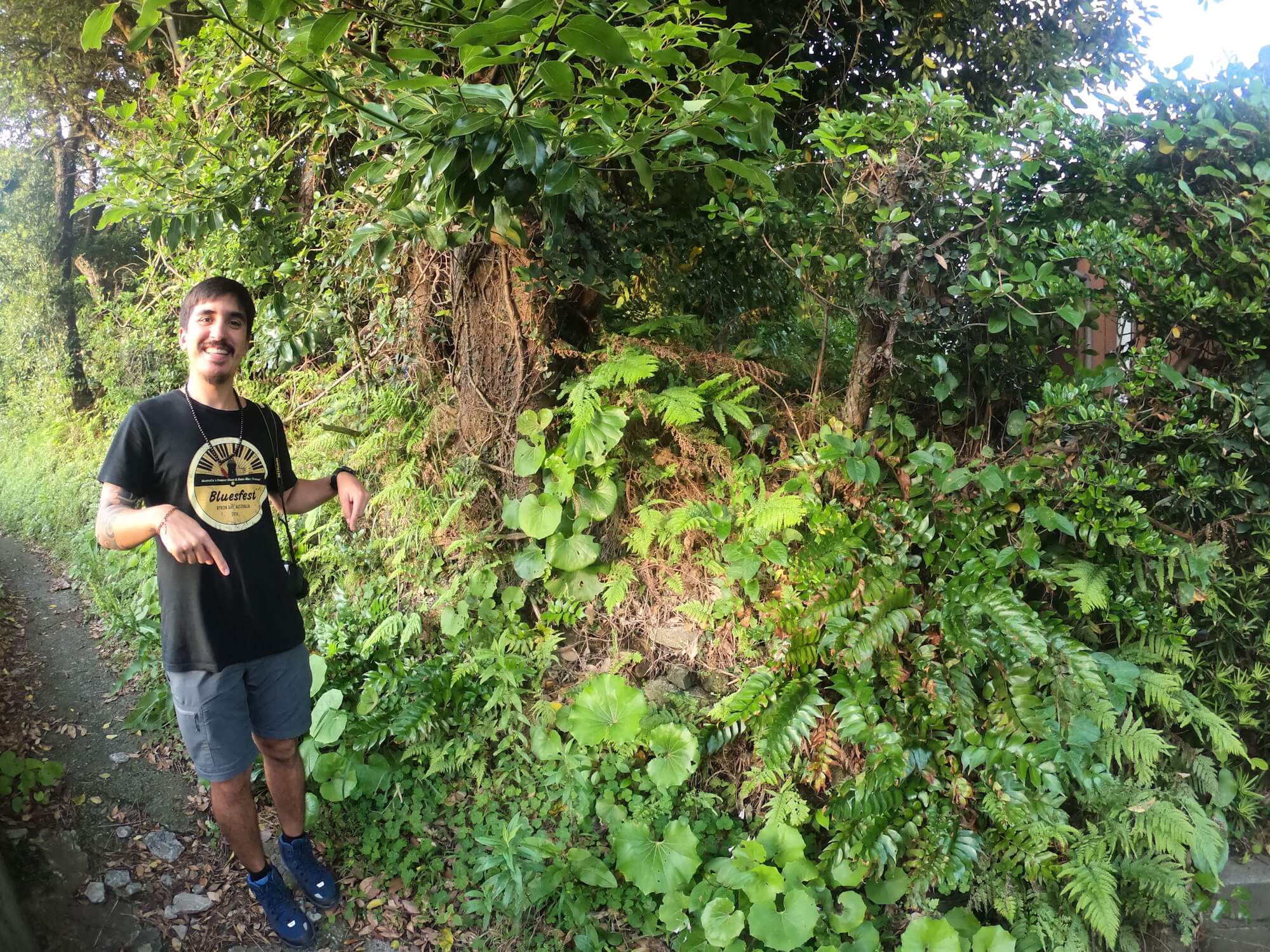Kagoshima: Em busca das origens -- The search of my origins
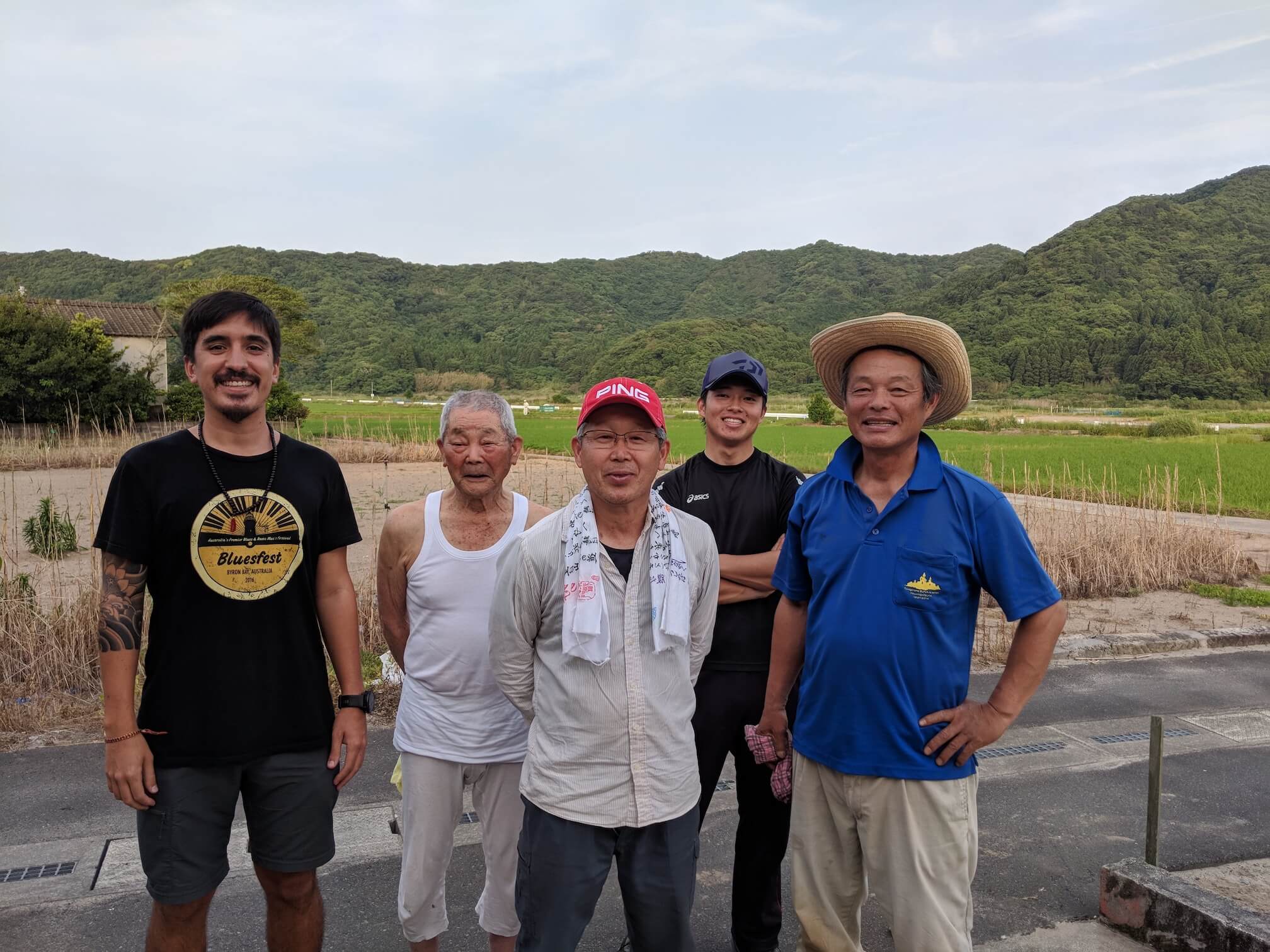
Português
Dedico esse post e essa jornada ao meu pai, Luis Agune, e a toda a minha família.
Como muito de vocês sabem, eu sou 1/4 japonês - o meu avô paterno, Kunio Akune, nasceu em 1898 em Kagoshima, Japão, e migrou ao Brasil em 1917, com apenas 19 anos. (O nome original da família é Akune, mas por um erro ortográfico de quando Kunio se mudou ao Brasil, virou Agune)
A história da família está muito bem contada pelo meu tio Roberto Meizi Agune no site do Centenário da Imigração Japonesa, então não entrarei em muito detalhes sobre essa parte. O que vou falar aqui é sobre minha experiência em Kagoshima, cidade natal do meu avô, e as aventuras vividas na busca por mais informações sobre a família.
Quando eu e a Alex incluímos Japão na nossa viagem, decidimos adicionar Kagoshima ao roteiro para ver se eu conseguia descobrir algo a mais sobre a minha família. O que não percebemos na hora é que Kagoshima fica no extremo sul da ilha Kyushu, a mais ao sul das ilhas principais do Japão. Mas lá fomos nós, embarcamos em uma viagem de 5h no trem bala de Kyoto pra Kagoshima.
Cidade de Kagoshima, com o vulcão Sakurajima ao fundo
Na primeira noite em que chegamos, nós conhecemos algumas pessoas bem legais no nosso albergue, e lá contamos o nosso motivo de estar em Kagoshima. Eu trouxe comigo uma carta escrita em inglês e em Japonês sobre o porque de eu estar lá, e algumas fotocópias de documentos do meu avô: seu passaporte, sua foto em 1917 e sua autorização para viajar quando saiu do Japão.
Munidos desses documentos e muita esperança, lá fomos nós começar a aventura. O que se desdobrou na sequencia foi uma série de eventos tão oportunos que até eu quase não acreditei. A nossa primeira parada foi a prefeitura da cidade de Kagoshima.
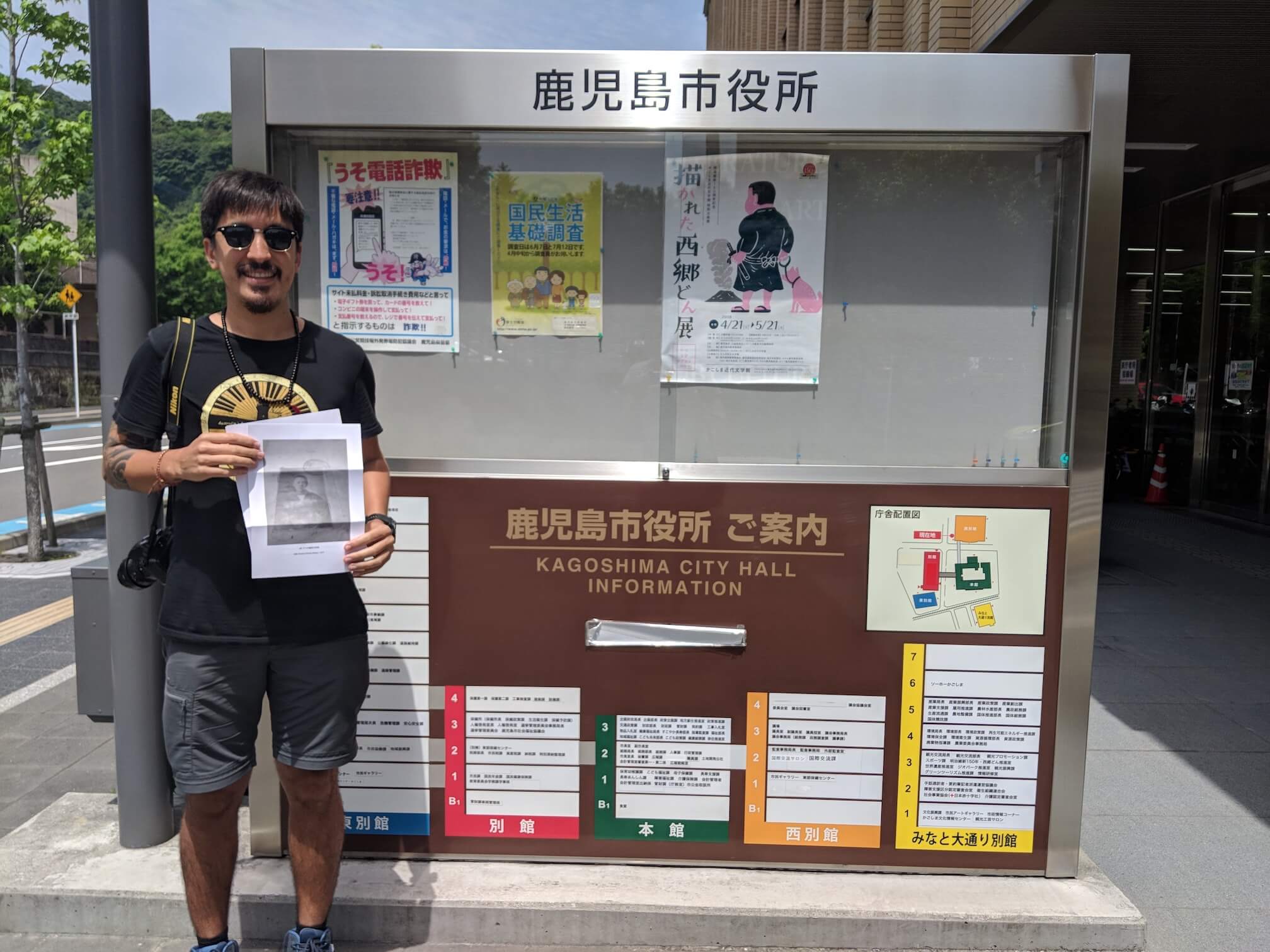
O começo da jornada, com os documentos na frente da prefeitura de Kagoshima
Entrando no prédio, percebemos que era mais um escritório do que qualquer coisa. Lá estávamos nós, no hall do prédio, com a maior cara de perdidos, quando um empregado nos viu e perguntou o que queríamos. Eu entreguei a carta para ele, e depois de ler, pediu para seguirmos ele, e nos encaminhou ao departamento de assuntos internacionais. Lá a nossa sorte começou - por acaso do destino, uma menina Australiana trabalhava no departamento. Além de se simpatizar com a nossa causa, ela fez de tudo ao alcance dela para nos ajudar. Traduziu para outros empregados o que queríamos, nos deu orientações, dicas, etc. Depois de mostrar os documentos a diversas pessoas, eles disseram que não havia nenhum registro da família Akune por ali, mas que olhando os documentos, eles acreditavam que talvez pudéssemos achar algo na cidade de Minamisatsuma.
Minamisatsuma também fica na prefeitura de Kagoshima, mas a cerca de 40km da cidade de Kagoshima. Nós olhamos no Google Mapas, e demoraria 3h para chegar lá de transporte público - ou 1h de carro. Não sabendo se valia a pena a jornada sem ter a certeza se encontraríamos algo por lá, eu e a Alex decidimos ir almoçar e pensar no próximo passo.
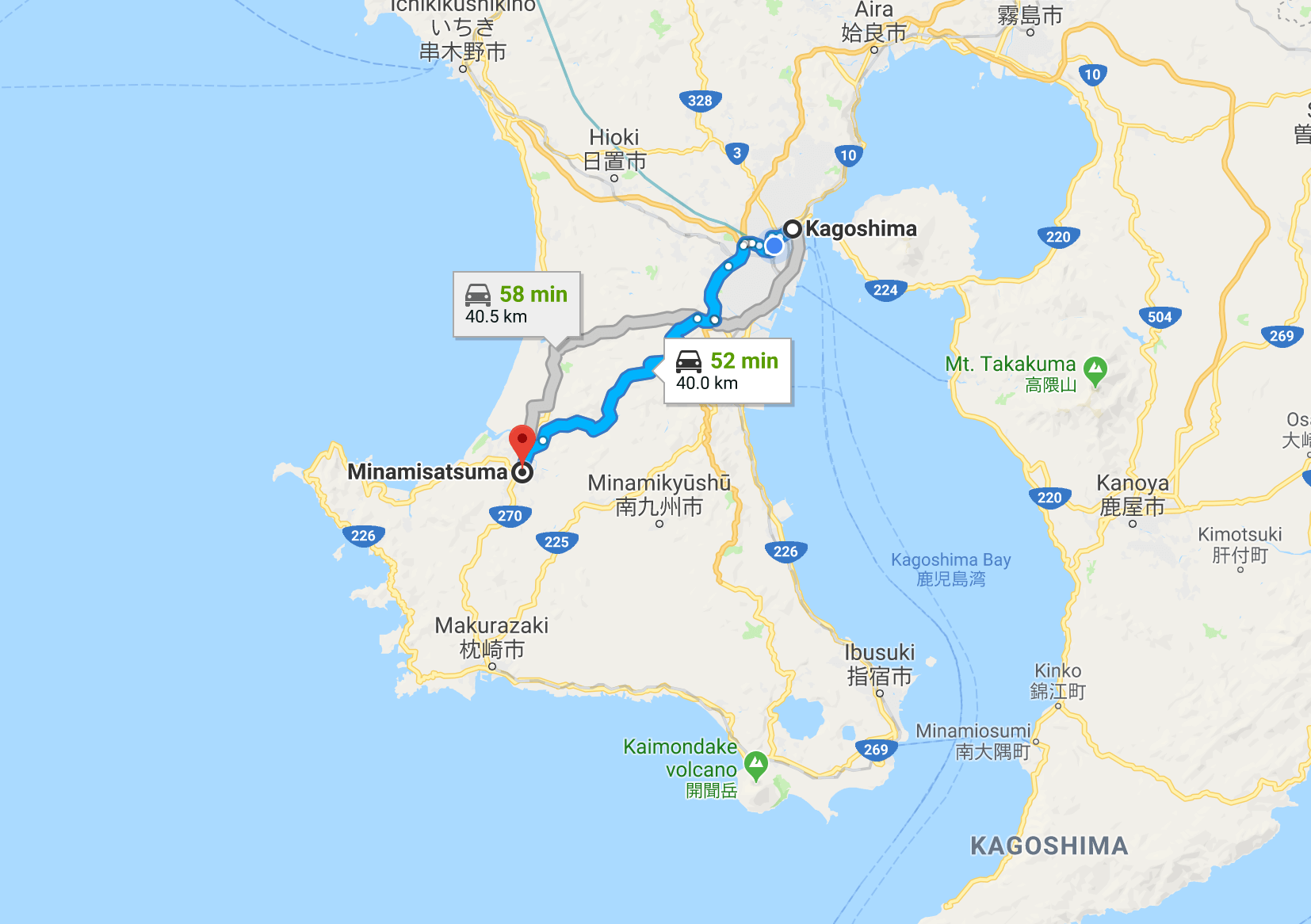
Distância entre Kagoshima e Minamisatsuma
Nós decidimos ir almoçar no restaurante que as pessoas que conhecemos no albergue nos indicaram - e lá (olha a nossa sorte de novo), encontramos um francês e uma japonesa do nosso albergue. Eles perguntaram como nossa descoberta estava indo, e contamos a eles sobre o nosso semi-proresso. A japonesa (que agora aproveito para dar o nome dela - Noriko, mas que poderia muito ser chamada de Nosso Anjo da Guarda) prontamente falou que adoraria ir com a gente para Minamisatsuma, caso a gente realmente fosse. A família dela é de Kagoshima, e ela fala o dialeto local, além de japonês e inglês.
Depois do almoço, agora em três - eu, Alex e Noriko - fomos à uma loja de carro da cidade para ver se tinha algo disponível de imediato. Na primeira loja que entramos, eles não aceitavam carteira internacional de habilitação, então falaram para tentarmos na loja da Toyota, na rua de trás. Lá fomos nós, e conseguimos um carrinho básico por meio dia por um preço razoável. Enquanto cuidávamos da papelada, Noriko contou a nossa história aos funcionários da loja. Foi aí que o gerente da loja disse que o tio da mulher dele é da família Akune, e que mora na região de Minamisatsuma! E foi assim que ouvimos do primeiro Akune no Japão, e que sabíamos que estávamos chegando perto de algo.
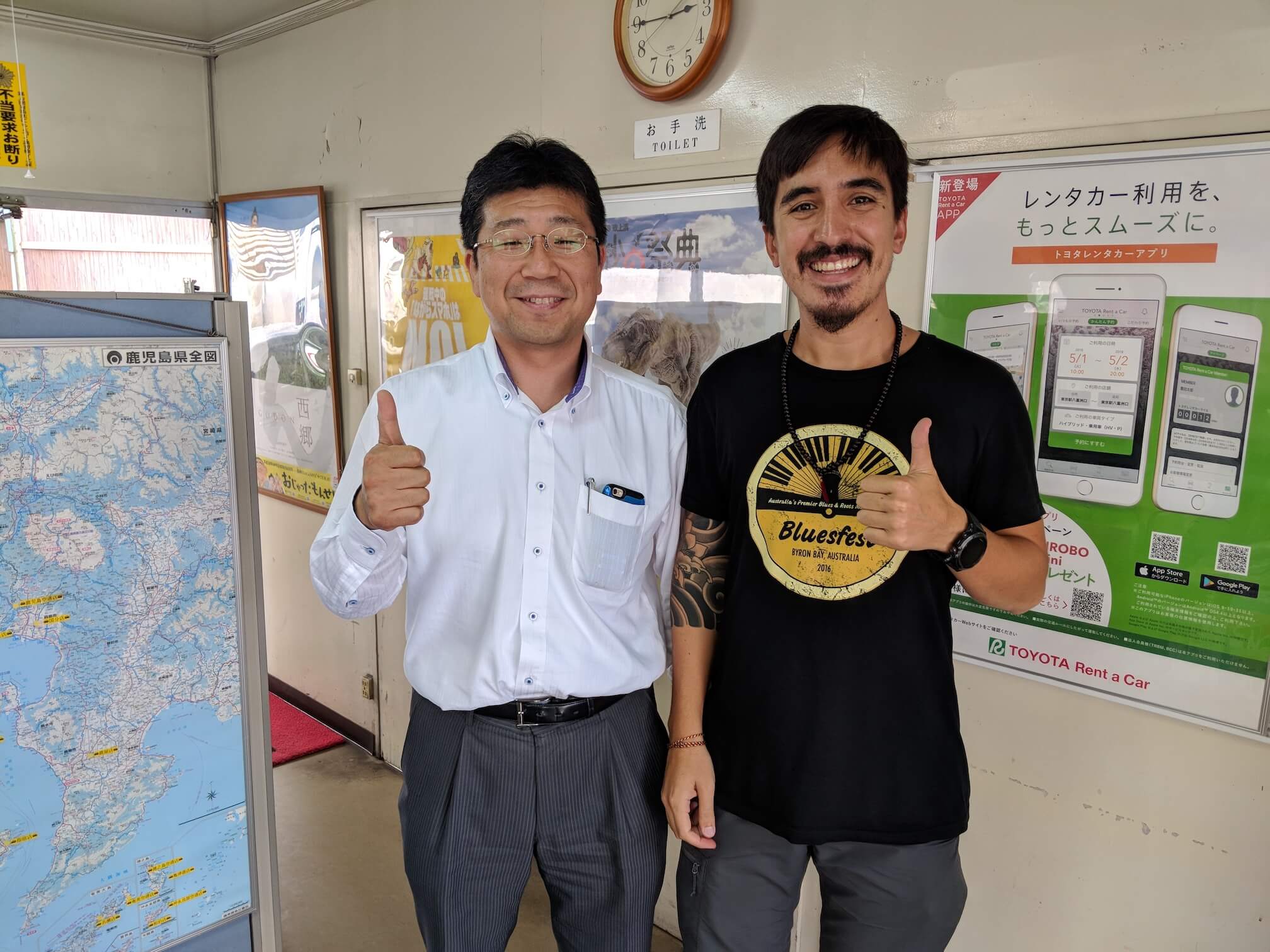
Com o gerente da loja da Toyota. O tio da mulher dele é da família Akune - estamos no caminho certo!
A estrada de Kagoshima pra Minamisatsuma é linda - montanhas verdes, plantações de arroz, paisagens lindas e calmas. Uma hora mais tarde, lá estávamos nós, na prefeitura de Minamisatsuma. Com a incrível ajuda de Noriko traduzindo entre Japonês e Inglês, eu entreguei meus documentos à moça do caixa, me perguntando “como é que nós viemos parar aqui?!”. Afinal, estávamos procurando informações do meu avô que nasceu há mais de 100 anos, em uma cidadezinha no meio do Japão!
Na estrada pra Minamisatsuma no nosso Toyotinha
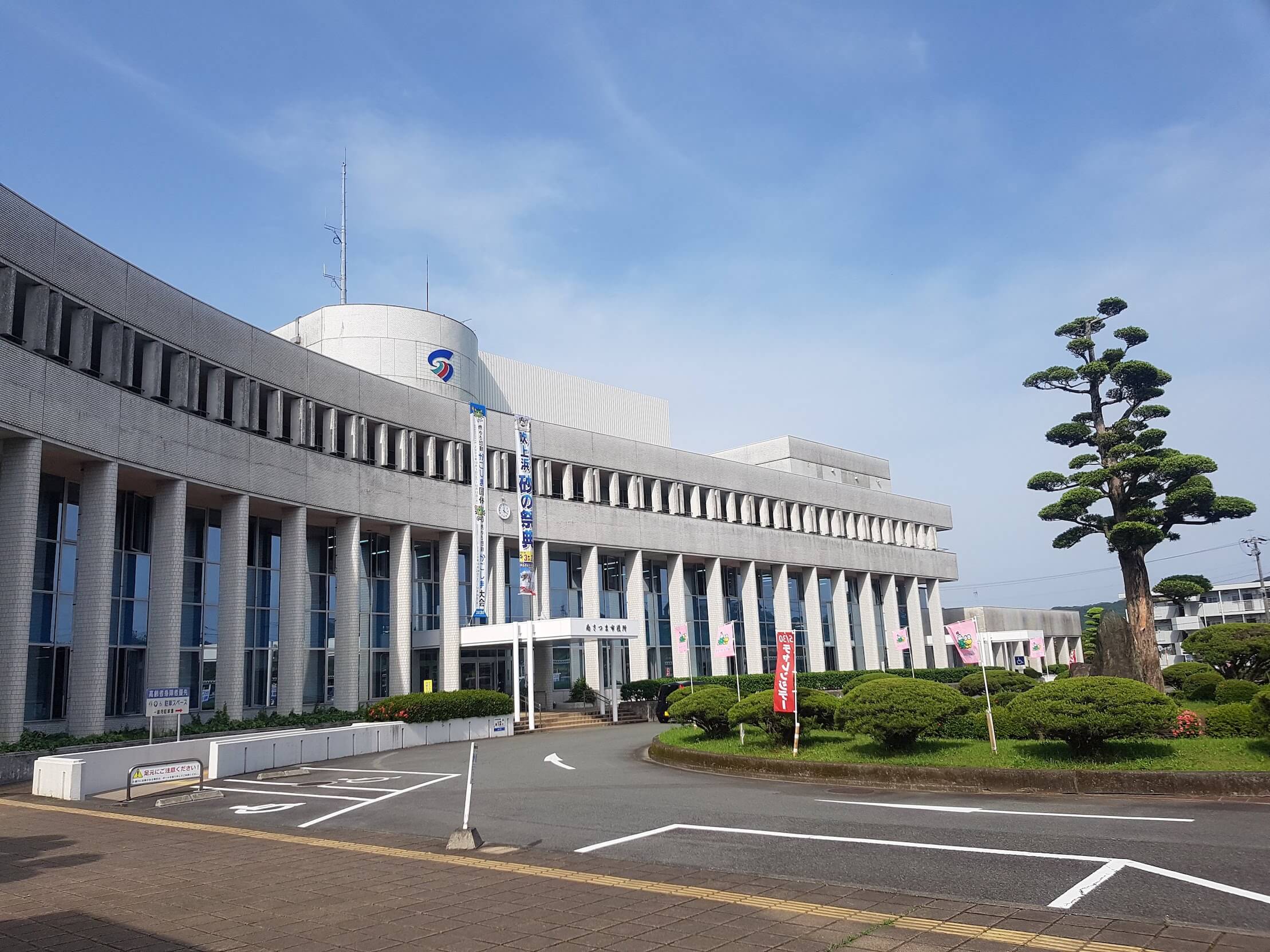
Prefeitura de Minamisatsuma, Kagoshima, Japão
Enfim, depois de preencher formulários, muita conversa entre nós, Noriko e a prefeitura, a moça foi lá nos arquivos da cidade, e voltou com cerca de 4 folhas de papel. ACHAMOS! Registros de nascimento, casamento e óbitos da família Akune, de cerca de 100 anos! Registrados na linda e pequena cidade de Minamisatsuma, ao extremo sul do Japão. Que sensação inexplicável. Lá estava o nascimento do meu avô, de seus irmãos, certidões de óbito e casamento… Por cerca de meia hora, com a Noriko fazendo a tradução em tempo real, traçamos ali mesmo a árvore genealógica do meu avô, segundo os registros. Importante ressaltar que a informação que tínhamos ali era apenas a em registro - se algum familiar não registrou casamento, nascimento ou falecimento de alguém, não teria como sabermos. Ao final da meia hora, chegamos a isso:
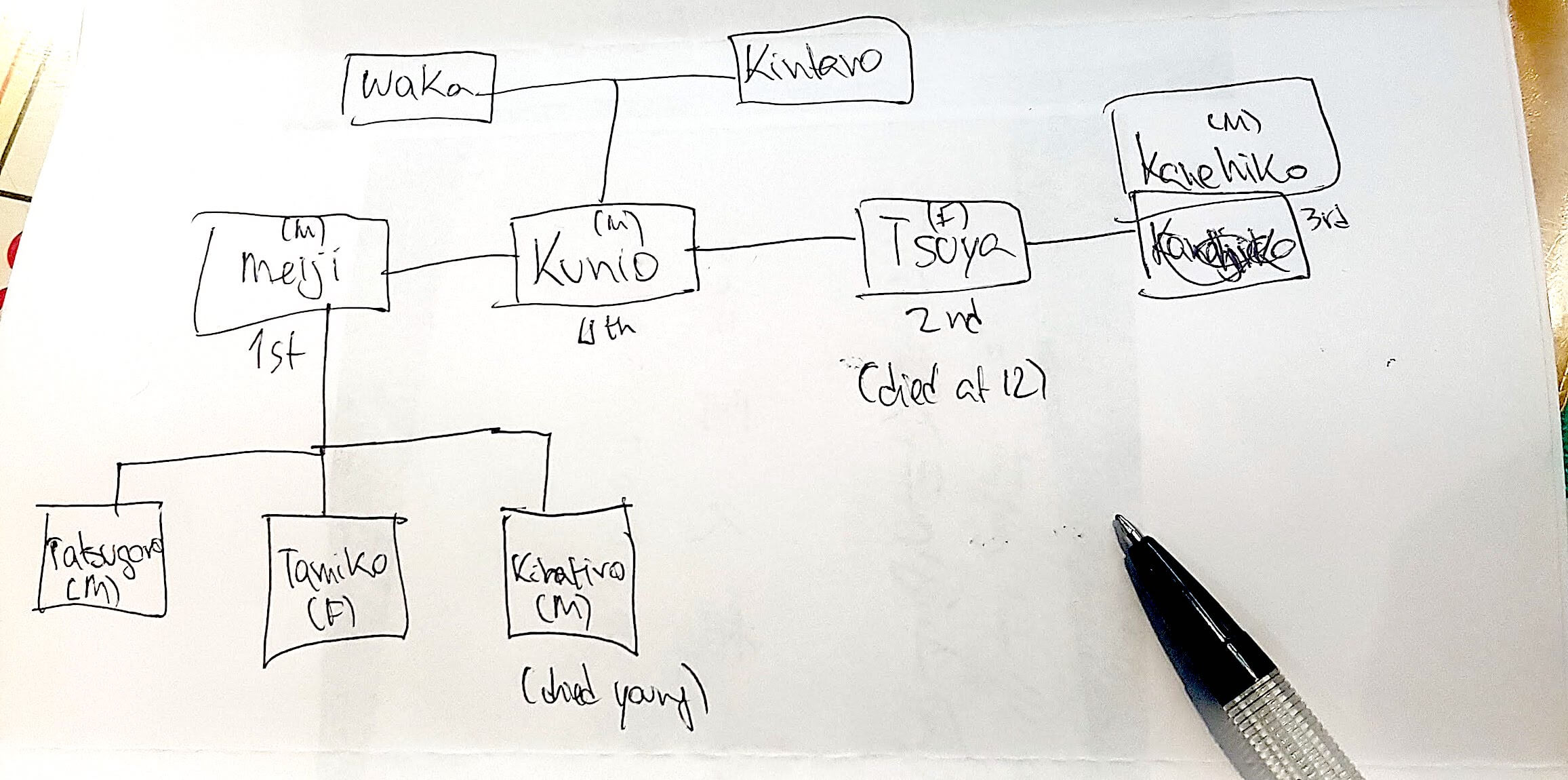
Rabisco da árvore genealógica da família Akune, segundo os registros

Traduzindo os registros da família Akune
Segundo os registros da cidade, Kunio era o quarto filho de Kintaro Akune (pai) e Waka Akune (mãe). Os dois filhos do meio (Tsuya e Kanehiko) falecerem ainda quando crianças, e o primeiro filho (Meiji, irmão mais velho do meu avô) teve três filhos - Tatsugoro, Tamiko e Kihatsiro. O governo japonês só autoriza familiares a verem até um certo nível de parentesco a árvore familiar, então não puderam me dar a identidade dos filhos de Tatsugoro, Tamijo ou Kihatsiro (ou nem dizer se algum deles teve filhos). Eu já estava extremamente feliz com o que descobrimos, mesmo não podendo ver toda a família. Mas nossa amiga Noriko não estava satisfeita. Ela continuou conversando com o pessoal da prefeitura, e um deles falou que a 5min de carro dali ficava uma pequena vila de pescadores chamada Kominato (significa “pequeno porto” em japonês) que tinha várias pessoas com o sobrenome Akune. Eles até nos deram o telefone de Matsumoto, o líder da comunidade local de Kominato, que falou que nos receberia naquele momento. Lá fomos nós, de novo, a um lugar ainda mais remoto para achar o Sr. Matsumoto. Depois de nos perdermos um pouco, nós finalmente o encontramos e ele nos levou a sua fazenda. Lá, ele chamou algumas pessoas da comunidade local e começou-se outra discussão em grupo sobre a família Akune. Um dos membros da comunidade tem o sobrenome Akune, porém não reconheceu nenhum dos nomes que estavam nos documentos da prefeitura. Outro membro da comunidade, um senhor de 91 anos, disse que ele conhecia Tatsugoro Akune. Disse que o conheceu rapidamente há muitos anos, que sabia que Tatsugoro trabalhou na companhia Kiuchu Eletricidade, mas que ele havia falecido havia alguns anos. Simplesmente inacreditável. Lá estávamos nós, no meio de um campo de arroz do Japão, com um cara que se chamava Akune, e outro que conheceu o sobrinho do meu avô. Como eu queria saber falar japonês para conversar com essas pessoas.
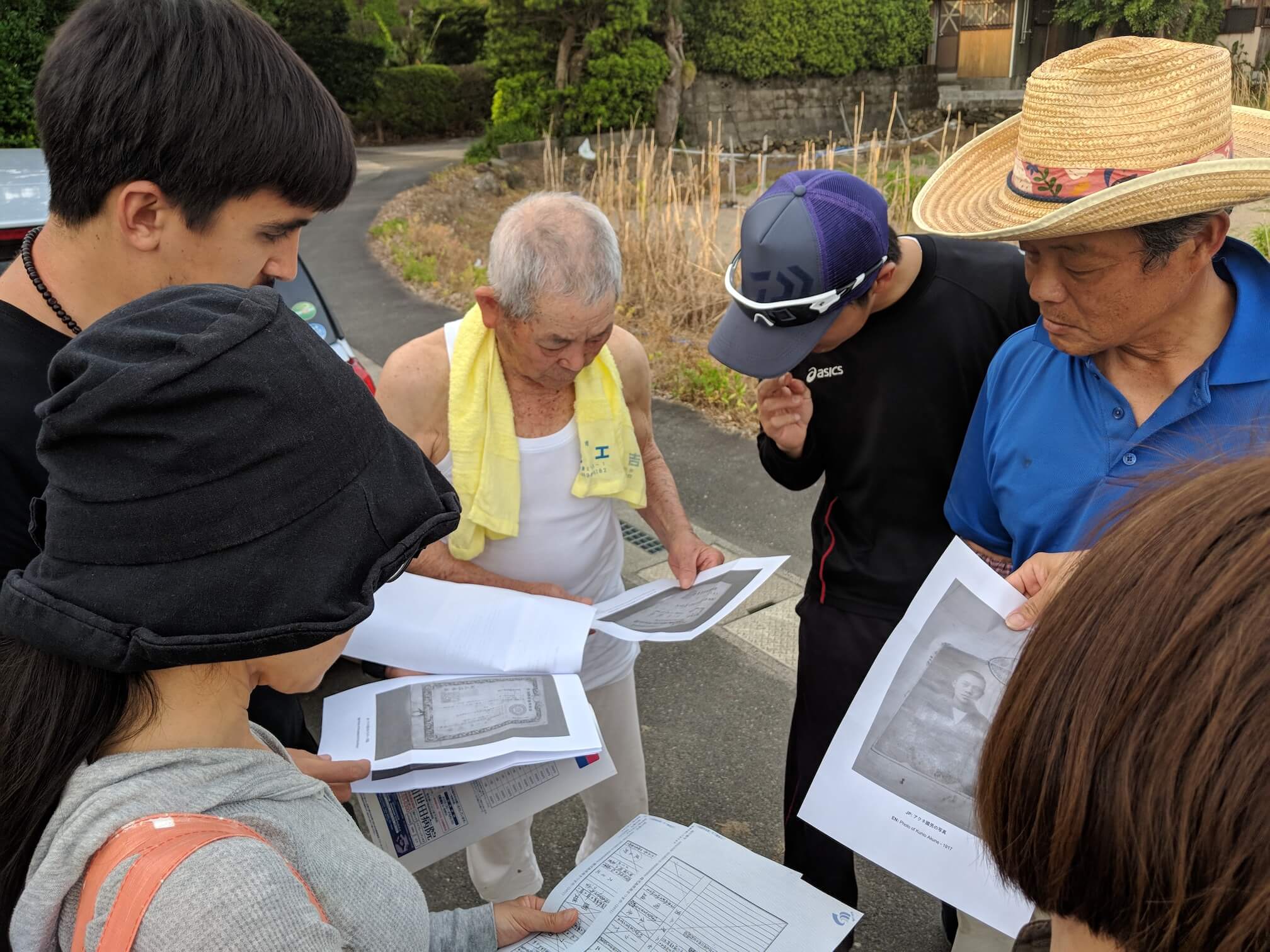
Reunião em Kominato, na fazenda do Senhor Matsumoto

Foto com os residentes de Kominato. Sr Matsumoto à direita, outro Akune ao meio.
Para finalizar, os documentos da prefeitura também indicaram o endereço de nascimento do meu avô, local que Matsumoto obviamente conhecia. Então eles fizeram questão de nos levar até lá. Eles disseram que antigamente a região era uma pequena montanha, mas que foi demolida para a construção de uma escola primária. Lugar lindo e tranquilo.

O exato local de nascimento de Kunio Akune, segundo os registros.
O exato local de nascimento de Kunio Akune, segundo os registros.
Com os corações cheios e apenas imaginando como teria sido a vida da família Akune na época, nós pegamos a estrada e dirigimos de volta a Kagoshima. Ainda não acredito na sorte que tivemos de encontrarmos pessoas maravilhosas no caminho para nos ajudar com a descoberta. Não fosse a australiana da prefeitura de Kagoshima e principalmente Noriko, eu e a Alex não teríamos descoberto nem metade do que descobrimos esse dia. Repassarei os documentos que encontrei para a minha família, e espero que isso possa, pelo menos em parte, realizar o sonho de meu avô Kunio, e de meu pai Luis, de visitar Kagoshima e descobrir um pouco mais sobre a família.
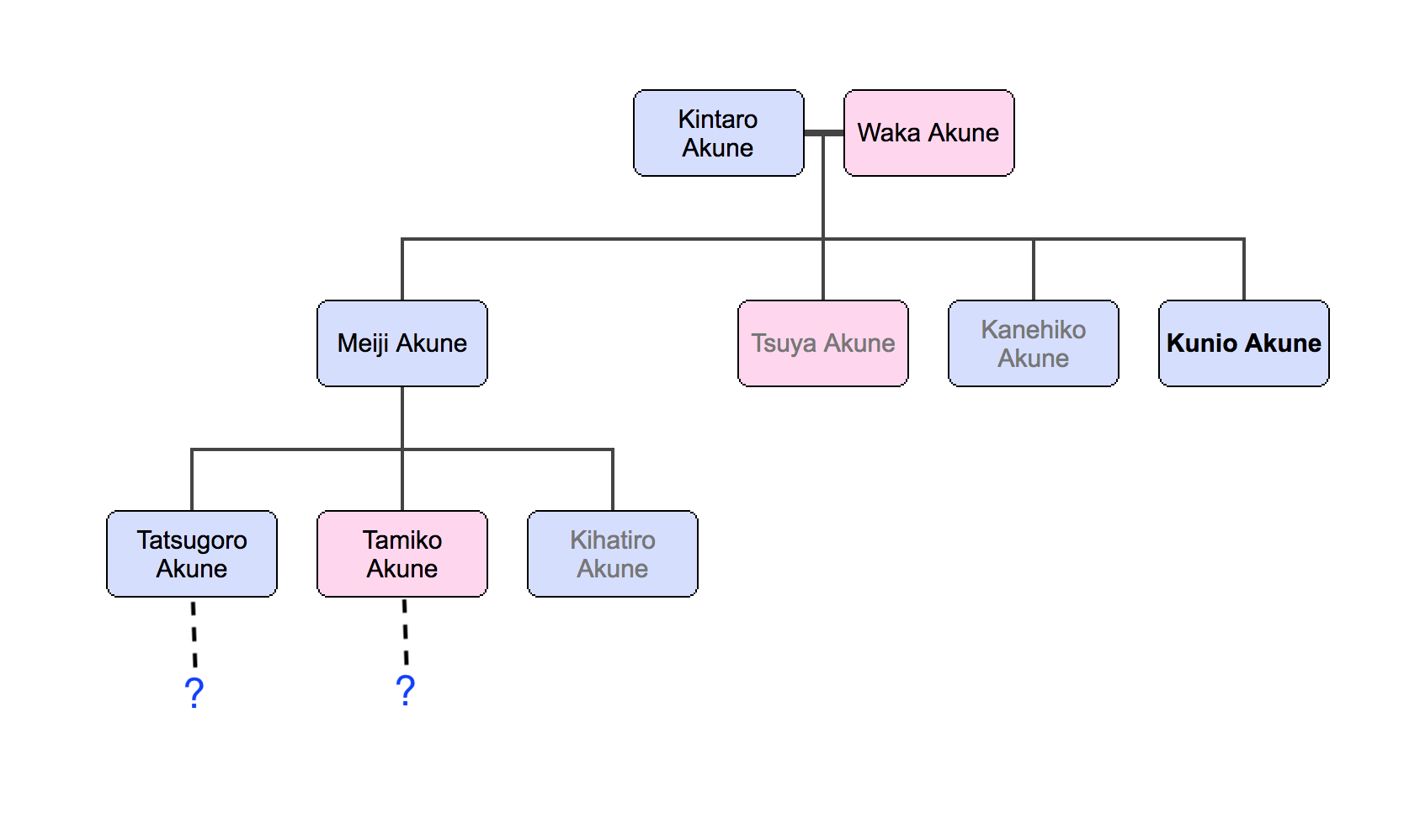
Árvore genealógica da época, segundo os registros
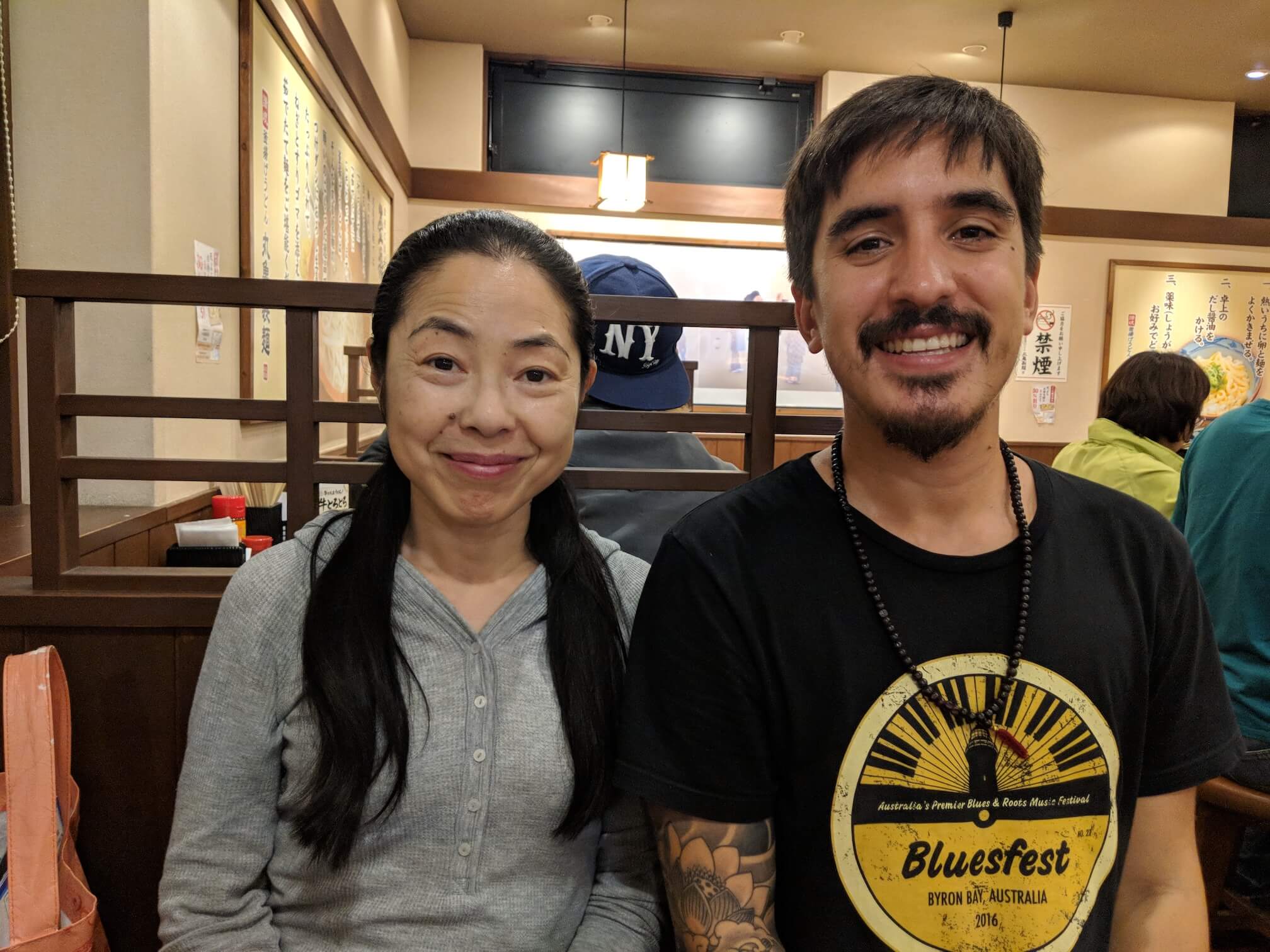
Foto com nosso anjo da guarda do dia, Noriko
English
I dedicate this post and this journey to my father, Luis Agune, and to my whole family.
As many of you might know, I am a quarter Japanese: my father’s dad, Kunio Akune, was born in 1898 in Kagoshima, Japan, and migrated to Brazil in 1917 when he was only 19, to flee from World War I. (The original spelling of the family name is Akune, but it was misspelled when Kunio migrated to Japan and became Agune)
Our family’s story is very well told by my uncle Roberto Meizi Agune on the Brazilian website of the Centenary of the Japanese Immigration, so I won’t get into much detail about this side of the story here. What I’ll talk about is my experience in Kagoshima, my grandfather’s hometown, and the journey that Alex and I went through in search of more information about my family.
When Alex and I added Japan to our world trip, we decided to also include Kagoshima in the itinerary to see if I could find anything about my family. What we didn’t realise back then was that Kagoshima sits on the South of Kyushu, the southmost island of mainland Japan. Anyway, off we went on a 5h bullet train ride from Kyoto to Kagoshima.
Kagoshima City, with Sakurajima volcano in the background
When we got to our hostel in Kagoshima, we met some very cool people who we ended up telling why we were in town. I brought with me a letter, written in English and Japanese, that explained why I was there and what I was trying to achieve, as well as some copies of my grandfather’s documents: his passport, his photo back in 1917 and his authorisation to travel when he left Japan, as he was too young to travel alone.
With those documents in hand and lots of faith in our hearts, off we went to our adventure. What happened next was a chain of unbelievably lucky events which I have a hard time grasping myself. Our first stop was Kagoshima City Hall.

The start of our journey, outside the Kagoshima City Hall
As soon as we walked into the building we realised it was more of a city office than anything else. There we were, in the middle of the building hall, looking completely lost when a man saw us and asked us in Japanese what we wanted. With little hope, I handed him the letter and, after reading, he asked us to follow him and took us to the Department of International Affairs. And that’s where our lucky started kicking in - it just so happened that an Australian girl worked there. Not only did she help us translate what we were trying to achieve to the other City Hall staff, but she also gave us tips, tried different people and truly embraced our mission. After showing our documents to a few different people, we found out that unfortunately there were no records under the name Akune in the Kagoshima City Hall. However, by looking at the documents, they believe that maybe we could find something in the nearby town of Minamisatsuma.
Minamisatsuma is also in the Kagoshima prefecture, but it’s about 40km away from Kagoshima city. A quick look at Google Maps showed us that it would take us 3h to get there by public transport, or 1h driving. Not knowing whether the journey was worth it without the certainty we’d find anything there, Alex and I decided to sit on it and go for lunch and think about the next steps.

Distance between Kagoshima and Minamisatsuma
We decided to have lunch at the restaurant that our friends from the hostel recommended us, and there (here’s our luck again), we bumped into a French guy and a Japanese lady from our hostel. They asked us how our research was going, and we told them about our small progress so far. The Japanese lady (which I’d like to introducer her now properly - Noriko, but could well be “Our Guardian Angel”) promptly said that she would love to come with us to Minamisatsuma, in case we decided to. Her family was from Kagoshima and she could speak not only the local dialect, but also Japanese and English.
After lunch, the now three of us - myself, Alex and Noriko - went to a car rental shop to see if they had anything available for that same afternoon. The first store we walked into wouldn’t take international drivers licence and told us to go to the Toyota rental store, down the street. We went there and we managed to find a suitable car at a reasonable price. While we were doing the paperwork, Noriko told the store employees our story and what we were trying to do. The store’s manager then said that his uncle’s wife was an Akune and that he lived precisely in Minamisatsuma! And that’s how we got to hear about the first Akune in Japan and we knew we were onto something.

With the Toyota rental car store manager. His uncle's wife is an Akune - we're on the right track!
The road from Kagoshima to Minamisatsuma is beautiful - green rolling hills, rice fields, in a nice and calm rural area. One hour later, we made to Minamisatsuma City Hall. With the outstanding help from Noriko with all the translations, I gave them my documents, asking myself “how did we get here?”. After all, we were looking for information about my grandfather who was born more than 100 years ago, in a city in the middle of nowhere in Japan!
On the road to Minamisatsuma in our little Toyota
After filling some forms and a lot of back and forth between us, Noriko and the City Hall, the staff member went back to her computer and printed out 4 sheets of paper. WE FOUND IT! Birth certificates, wedding certificates and death certificates of Akune family members, dating back from about 100 years. Registered in this small, beautiful city, at the very South of Japan. What a feeling. We found records of my grandfather’s birth, as well as his siblings, death certificate of family members, etc. For about half an hour, with Noriko doing real time translation, we drew right there and then my grandfather’s family tree. It’s worth noticing that the information we had there was only the one that was effectively registered - if any family member failed to register wedding, birth or death of anyone, we would not know it. After half an hour, this is what we got:

Draft of the family tree, according to the records

Translating and trying to make sense of the records
According to the records of the city hall, Kunio was the youngest of 4 children of Kintaro Akune and Waka Akune. The two middle children (Tsuya and Kanehiko) passed away when they were very young, and that the eldest (Meiji) had three children - Tatsugoro, Tamiko and Kihatsiro. The Japanese government only allows family members to see up until a certain point of the family tree, so they would not let us know whether any of Meiji’s children had offsprings. We would need to seek authorisation from a closer family member for that.
I was already extremely happy with what we’d discovered, but Noriko was not done yet. She kept on talking to the City Hall members and learned that there was a small fisherman’s village nearby called Kominato (which literally means “small harbour” in Japanese), where a large number of people named Akune live. They even gave us the contact details of Mr. Matsumoto, the local community leader of Kominato and who was happy to see us right there and then. We got a bit lost but eventually found Mr. Matsumoto, who took us to his farm. There, he gathered a few more community members and another discussion forum was created about the Akune family. One of the community members was Akune himself, but did not recognise any of the names in the papers from the City Hall records. Another member, a 91-year-old man, said that he once met Tatsugoro Akune. He said that they met briefly many years ago, and that Tatsugoro used to work for Kiuchu Electricity, but that he passed away a number of years ago. Simply unbelievable. There we were, in the middle of a rice plantation, with a guy named Akune himself and another one who met my grandfather’s nephew. I only wish I could speak Japanese so I could talk to these people myself.

Gathering at Matsumoto's farm, in Kominato

Photo with the residents of Kominato. Mr Matsumoto on the right, and another Akune in the middle.
To close it off, the records from the City Hall gave the birthplace of my grandfather, which Matsumoto obviously knew where it was. They offered to drive us there, and said that the area used to be a mountain, but that has since been demolished to make place for a elementary school that is there today. Beautiful and tranquil place.

The exact birthplace of Kunio Akune, according to the records
The exact birthplace of Kunio Akune, according to the records
With our hearts full and only imagining what life would’ve been like back then, we hit the road back to Kagoshima City. I still have a hard time believing how lucky we were that they and the amazing help from these wonderful people we met along the way. If it wasn’t for the Australian girl at the Kagoshima City Hall and especially for Noriko, Alex and I wouldn’t have gone half the way we went that day. I will pass these documents on to my family and I hope that this journey of mine could - at least in part - help fulfil my grandfather’s and my father’s dream of going back to Kagoshima to learn a bit more about the family history.



